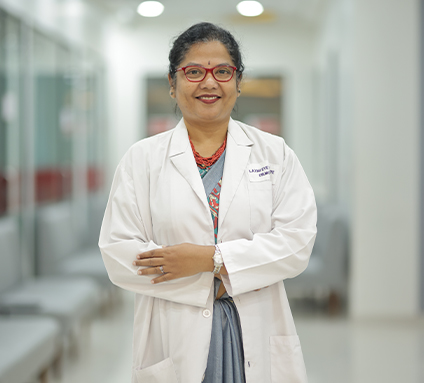Squint Eye Treatment in Navi Mumbai
At Laxmi Eye Institute, Internationally recognized eye hospital in Navi Mumbai, centres at Panvel, Kharghar, Kamothe and Dombivali.

Laxmi Eye Hospital and Institute offers specialized care for children with squint, a condition where the eyes are misaligned and do not point in the same direction. Squint can lead to vision problems, eye strain, and difficulty with eye coordination, which can affect a child's quality of life and development. Our team of pediatric eye care specialists uses advanced diagnostic tools and techniques to accurately diagnose and treat squint in children.
What is Squint (Strabismus)?
A squint, medically known as strabismus, is a vision disorder where the eyes do not align in the same direction. While one eye looks straight ahead, the other may turn inward (esotropia), outward (exotropia), upward (hypertropia), or downward (hypotropia). This misalignment can be constant or occur occasionally, affecting both children and adults. If left untreated, a squint can lead to double vision, poor depth perception, and even permanent vision loss in the weaker eye (amblyopia or "lazy eye"). Early diagnosis and treatment are crucial to restoring proper eye function and preventing long-term complications.
The Most Common Types of Squint
Squint comes in different shapes and forms, and each one can affect vision in its own unique way. Let's break it down:

Esotropia: This happens when one eye turns inward. Think of it as the "cross-eyed" look. It's often noticed in children but can also develop in adults.
Exotropia: The opposite of esotropia, this is when one eye drifts outward. People with exotropia may notice their eye wandering when they're tired or distracted.
Hypertropia: In this case, one eye turns upward. It's less common but can be a result of nerve issues or trauma.
Hypotropia: When one eye turns downward, it can affect your ability to focus on objects properly and even make it hard to see things at eye level.
What Are the Causes of Squint (Strabismus)?
Squint doesn't just happen for no reason. There are a few common culprits behind it:
Genetics: If your parents or relatives had squint, you might be more likely to have it, too. Sometimes, it runs in families.
Vision problems: Uncorrected refractive issues like farsightedness can sometimes lead to squint, as your brain struggles to focus both eyes on a single point.
Neurological conditions: Certain conditions like stroke, cerebral palsy, or brain injuries can disrupt the normal function of the eye muscles, causing squint.
Injury: If you've had a head injury or trauma around the eyes, it can affect the muscles that control eye movement.
Developmental issues: In some cases, squint can be a sign of something more complex happening during eye or brain development.
Here are some reasons for squint in kids:
Refractive errors such as nearsightedness, farsightedness, or astigmatism
Problems with the eye muscles that control eye movement
Neurological conditions such as cerebral palsy or brain tumors
Eye injuries or infections
Genetics
Treatment Options for Squint (Strabismus)
When it comes to treating squint, there's no one-size-fits-all approach. Depending on the type and severity, your treatment could be:
Eyeglasses or Contact Lenses: If a refractive issue is the cause, simply wearing glasses or contacts might be enough to help align your eyes.
Vision Therapy: Eye exercises that strengthen the eye muscles and improve coordination. Think of it as gym for your eyes.
Eye Patching: For children with amblyopia (lazy eye), patching the stronger eye can help the weaker eye work harder and improve vision.
Botox Injections: In some cases, a botox injection can help relax overactive eye muscles, allowing for better alignment.
Squint Surgery: For those with more severe or long-standing squint, surgery may be the best option. This involves adjusting the eye muscles to realign the eyes. The surgery is often very successful and can drastically improve both appearance and vision.
Squint Surgery Cost in Mumbai
The cost of squint surgery in Mumbai can vary significantly depending on multiple factors. However, the final price may vary depending on several factors:
Type of Strabismus : The complexity of the squint (esotropia, exotropia, hypertropia, etc.) influences the surgical approach and cost.
Type of Surgery : Some cases require simple muscle adjustments, while others may need advanced techniques, affecting the overall expense.
Surgeon's Expertise : A squint specialist or highly experienced ophthalmologist may have higher fees but ensures better precision and outcomes.
Patient's Age : Surgery for children often requires general anesthesia and extra care, which may increase costs compared to adult strabismus surgery.
First-Time vs. Revision Surgery : A repeat (revision) squint surgery is usually more complex and costly than a first-time procedure.
We understand that squint can have a significant impact on a child's vision and overall quality of life. Our team is committed to providing compassionate, high-quality care to help children achieve optimal visual outcomes and lead happy, healthy lives. We work closely with parents and caregivers to ensure that children receive the support and care they need to manage their condition effectively.
Make An Appointment
Our Squint Eye Surgeon in Navi Mumbai

Dr. Monica Samant
Paediatric, squint & Neuro Ophthalmologist Navi MumbaiDr. Monica Samant, our expert in paediatric, squint, and neuro-ophthalmology, provides specialized eye care services in Navi Mumbai Laxmi Eye Institute & Hospital, an internationally recognized eye hospital with centres at Panvel, Kharghar, Kamothe, and Dombivali.Dr. Monica Samant ensuring compassionate and advanced eye care for children.
All Copyright© Reserved @ Laxmi Eye Hospital And Institute
